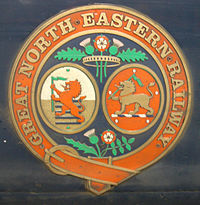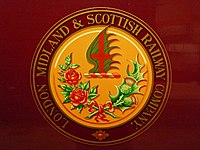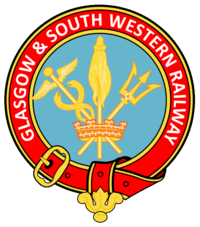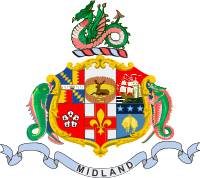
Heraldry is a discipline relating to the design, display and study of armorial bearings, as well as related disciplines, such as vexillology, together with the study of ceremony, rank and pedigree. Armory, the best-known branch of heraldry, concerns the design and transmission of the heraldic achievement. The achievement, or armorial bearings usually includes a coat of arms on a shield, helmet and crest, together with any accompanying devices, such as supporters, badges, heraldic banners and mottoes.
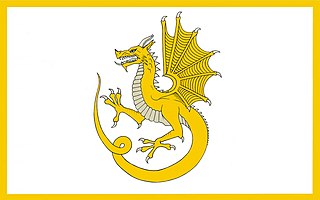
The wyvern is a type of mythical dragon with two legs, two wings, and often a pointed tail which is said to be a venomous stinger.

Earl Haig is a title in the peerage of the United Kingdom. It was created in 1919 for Field Marshal Sir Douglas Haig. During the First World War, he served as commander of the British Expeditionary Force on the Western Front in France and Belgium (1915–18). Haig was made Viscount Dawick and Baron Haig, of Bemersyde in the County of Berwick, at the same time he was given the earldom, also in the peerage of the United Kingdom The viscountcy of Dawick is used as a courtesy title by the Earl's son and heir apparent. As of 2022 the titles are held by the first earl's grandson, the third earl, who succeeded his father in 2009.
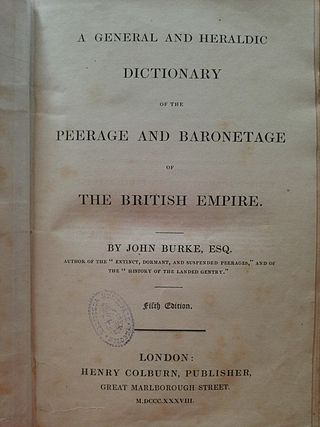
Burke's Peerage Limited is a British genealogical publisher founded in 1826, when the Anglo-Irish genealogist John Burke began releasing books devoted to the ancestry and heraldry of the peerage, baronetage, knightage and landed gentry of Great Britain and Ireland. His first publication, a Genealogical and Heraldic Dictionary of the Peerage and Baronetage of the United Kingdom, was updated sporadically until 1847, when the company began publishing new editions every year as Burke's Peerage, Baronetage and Knightage.
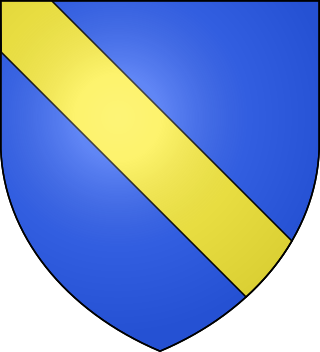
In heraldry, a bend is a band or strap running from the upper dexter corner of the shield to the lower sinister. Authorities differ as to how much of the field it should cover, ranging from one-fifth up to one-third.
In heraldry, or is the tincture of gold and, together with argent (silver), belongs to the class of light tinctures called "metals". In engravings and line drawings, it is hatched using a field of evenly spaced dots. It is very frequently depicted as yellow, though gold leaf was used in many illuminated manuscripts and more extravagant rolls of arms.

The enfield is a fictitious creature sometimes used in heraldry.

Arthur Charles Fox-Davies was a British expert on heraldry. His Complete Guide to Heraldry, published in 1909, has become a standard work on heraldry in England. A barrister by profession, Fox-Davies worked on several notable cases involving the peerage, and also worked as a journalist and novelist.

English heraldry is the form of coats of arms and other heraldic bearings and insignia used in England. It lies within the so-called Gallo-British tradition. Coats of arms in England are regulated and granted to individuals by the English kings of arms of the College of Arms. An individual's arms may also be borne 'by courtesy' by members of the holder's nuclear family, subject to a system of cadency marks, to differentiate those displays from the arms of the original holder. The English heraldic style is exemplified in the arms of British royalty, and is reflected in the civic arms of cities and towns, as well as the noble arms of individuals in England. Royal orders in England, such as the Order of the Garter, also maintain notable heraldic bearings.

The coat of arms of Colchester City Council is the coat of arms granted to Colchester City Council, which is the local authority for the district of Colchester, Essex, England. The arms were first granted by Henry V in 1413.
Cornish heraldry is the form of coats of arms and other heraldic bearings and insignia used in Cornwall, United Kingdom. While similar to English, Scottish and Welsh heraldry, Cornish heraldry has its own distinctive features. Cornish heraldry typically makes use of the tinctures sable (black) and or (gold), and also uses certain creatures like Cornish choughs. It also uses the Cornish language extensively for mottoes and canting arms.
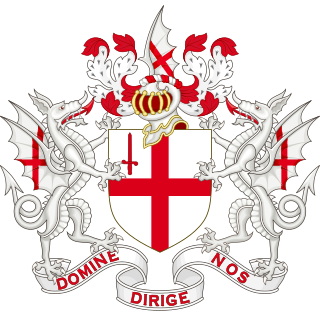
The coat of arms of the City of London Corporation is the official coat of arms granted to the City of London Corporation. The Corporation governs the City of London, one of the 33 administrative areas within Greater London, England.

In heraldry, the term sea-lion refers to a legendary creature that has the head and upper body of a lion, but with webbed forelimbs and a fish tail. These occur most frequently as supporters, but also occur as crests and occasionally as charges. Sea-lions are frequently found in "sejant" or "sejant-erect" attitudes, but may also be found "naiant" or "assurgeant".
Most prime ministers of the United Kingdom have enjoyed the right to display coats of arms and to this day, prime ministers have their ancestral arms approved, or new armorial bearings granted, either by the College of Arms or the Lyon Court.

The coat of arms of the Prince of Wales is the official personal heraldic insignia of the Princes of Wales, a title traditionally granted to the heir apparent of the reigning monarch of the United Kingdom of Great Britain and Northern Ireland, formerly the Kingdom of Great Britain and before that the Kingdom of England.

The armorial of British universities is the collection of coats of arms of universities in the United Kingdom. Modern arms of universities began appearing in England around the middle of the 15th century, with Oxford's being possibly the oldest university arms in the world, being adopted around the end of the 14th century. The earliest granting of university arms was to King's College Cambridge by Henry VI in 1449. Arms are granted by the College of Arms and Lyon Court. It has been suggested that new universities register arms in an attempt to appear more traditional or legitimate. As corporations, older university arms have historically been granted without a crest, however newer institutions use crests with mantling, including new colleges at older universities. The first crest granted to a university was to Leeds in 1905 while the first British university to be granted supporters was Sussex in 1962, although both Oxford and Cambridge have used angels as supporters and Cambridge has used the 'alma mater' emblem as a crest without these components being officially granted.

The coat of arms of Imperial College London is an heraldic emblem used by Imperial College London. Edward VII granted the college the arms on the 6 June 1908 by royal warrant. It is blazoned:
Per fesse in chief the Royal Arms of the United Kingdom of Great Britain and Ireland, in base or, an open book proper inscribed with the word "Scientia"

The following is an armorial of the individuals, who have served as governor-general of New Zealand.

The following is an armorial of the thirty individuals, who have served as governor general of Canada since Confederation.
The following is an armorial of the individuals who have served as governor-general of the Commonwealth of Australia.
